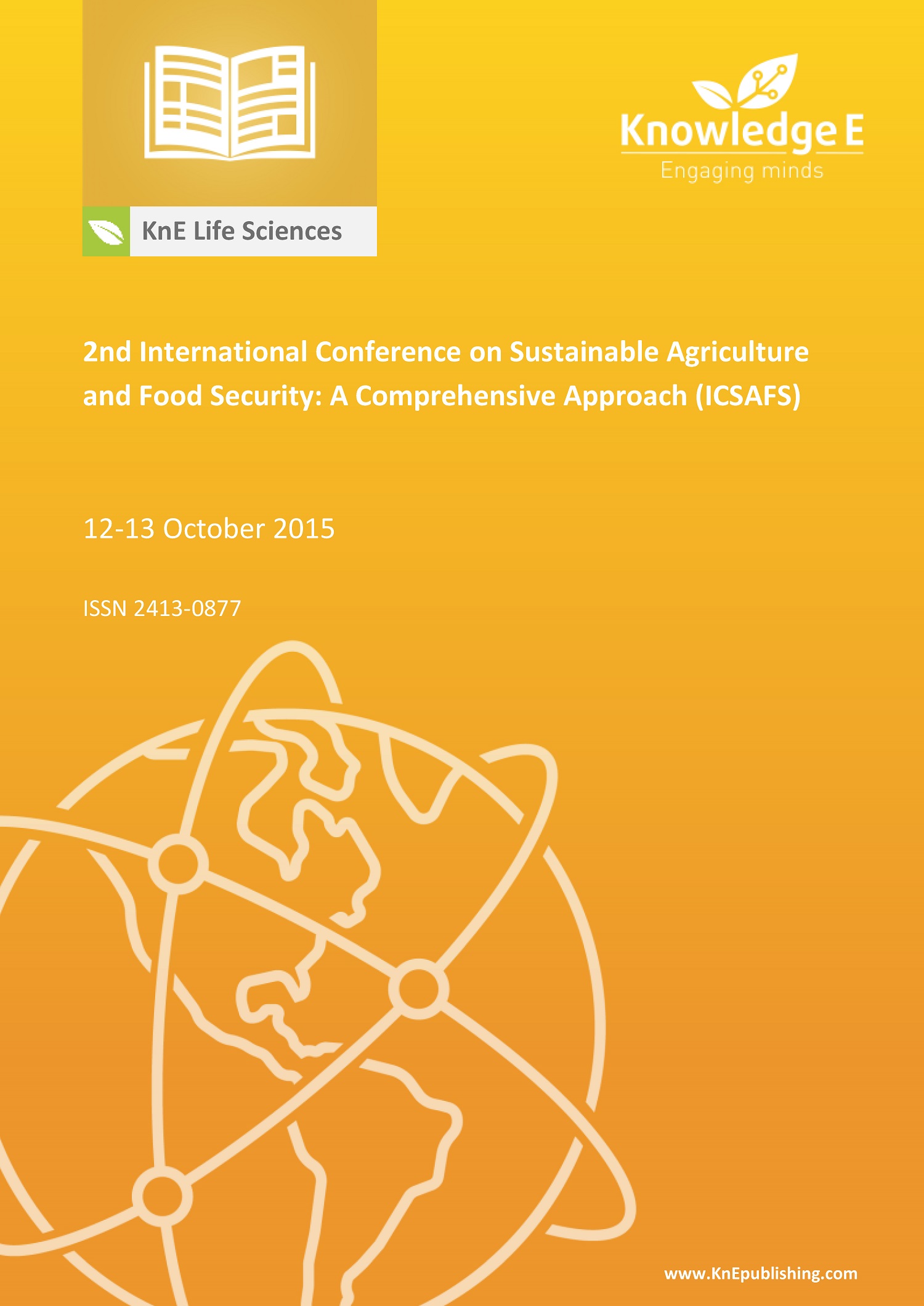The Abilities of Endophytic and Biofertilizing Bacteria and Their Combinations to Suppress Bacterial Wilt Disease (Ralstonia solanacearum) of Chili
DOI:
https://doi.org/10.18502/kls.v2i6.1052Abstract
Bacterial wilt disease (Ralstonia solanacearum) is one of the most important diseases in Solanaceae, including chili. Biological control is one of environmentally-friendly method for controlling plant diseases. Microbes that are potential as biological control agents include bacterial endophytes and bacteria that are usually used as biofertilizer. This paper discusses the result of the study that examined the abilities of endophytic and biofertilizing bacteria solely or in combination to suppress bacterial wilt disease (R. solanacearum). The endophytic bacteria isolates tested were Lysinibacillus sp. and Bacillus subtilis, while biofertilizing bacteria used were N-fixing bacteria (Azotobacter chrococcum) and P-solubilizing bacteria (Pseudomonas cepacea). The results showed that the endophytic bacteria, biofertilizing bacteria and their combination inhibited wilt disease incidence in chili by 46.7-80 %. The highest disease suppression (80 %) showed by the endophytic bacteria, B. subtilis. This endophyte was also able to promote a significant chili growth.
Keywords: Ralstonia solanacearum, Endophytic bacteria, Biofertilizer, Biological control, Chili.
References
Wall, G.C. 2000. Bacterial Wilt (Ralstonia solanacearum) (syn. Burkholderia, Pseudomonas solanacearum). Agricultural Development in American Pacific (ADAP). Available on line http://www.ctahr.hawaii.edu/adap/Publications/ADAP_pubs/2000-2.pdf.
Agrios, G. N. 2005. Plant Pathology. Fifth edition. Academic Press, New York.
Backman, P.A and R.A Sikora. 2008. Endophytes: An emerging tool for biological control. Biological Control 46:1–3
Haggag, W. M. 2010. Role of Endophytic Microorganisms in Biocontrol of Plant Diseases. Life Science Journal, 7(2):57-62
Istifadah, N and Putri, D. D. 2007. Kemampuan Bakteri Endofit Akar Tanaman Kubiskubisan untuk Menekan Penyakit Akar Gada (Plasmodiophora brassicae Wor.) pada tanaman kubis (The abilities of endophytic bacteria from crufiferae roots to suppress club root disease in cabbage). J. Agrikultura 18: 210-216.
Istifadah, N. 2011. Endophytes from Cabbage Roots: Their Influences on Growth and Pathogens of Cabbage. Proceeding of International Seminars on Biotechnology. Bandung.
Istifadah, N. P. Suryatmana and B.N Fitriatin. 2014. Pengembangan Formulasi Konsorsium Mikroba untuk Pupuk Hayati dan Biopestisida pada Tanaman Cabai. Laporan Penelitian Unggulan Perguruan Tinggi (PUPT), DP2M DIKTI, LPPM, Unpad, Bandung. (The development of formulation of microbial consortium as biofertilizer
and biopesticide in chili plant. Research Report, DP2M DIKTI, Unpad, Bandung).
Kloepper, J.W and C-M Ryu. 2006. Bacterial endophyte as elicitors of systemic induced resistance. In Soil biology vol 9: Micrbial Root Endophytes. (D. Schulz, C. Boyle, TN Sieber, Eds): pp. 34-52. Springer Verlag, Berlin.
Fitriatin, B.N., A. Yuniarti, T.Turmuktini and M. Saman. 2013. Effect of P solubilizing microbe producimg growth regulators to increase solubilizing of soil phosphate and yield of maize on marginal soil. Soil –Water Journal. Vol 2. Number 2 (1). pp. 547 – 554.
Fitriatin, B.N., A. Yuniarti, and T. Turmuktini. 2014. The effect of phosphate solubilizing microbe producing growth regulators on soil phosphate, growth and yield of maize and fertilizer efficiency on Ultisol. Eurasian Journal of Soil Science Vol 3 pp. 104 -107.
Hindersah, R., D. H Arief, S. Soemitro, L. Gunarto. 2006. Exopolysaccharide Extraction from Rhizobacteria Azotobacter sp. Proc. International Seminar IMTGT. Medan, 22-23 Juni 2006. Pp. 50-55
Hindersah, R., A.P. Hidayat, M. Arifin. 2009. Pengaruh Inokulasi Azotobacter terhadap Produksi dan Kandungan Kadmium Tajuk Selada yang ditanam di Andisols Terkontaminasi Kadmium (The effect of Azotobacter inoculation on Yield and Cadmium in lettuce grown in Cd-conatminated andisols). J. Agrikultura 20:171-175
Kumar V., A. Kumar and R. N. Kharwar. 2007. Antagonistic potential of fluorescent pseudomonads and control of charcoal rot of Chickpea caused by Macrophomina phaseolina.Journal of Environmental Biology: 28: 15-20
Mali G.V. and M.G. Bodhankar Antifungal and Phytohormone Production Potential of Azotobacter chroococcum Isolates from Groundnut (Arachis hypogea L.) Rhizosphere. 2009. Asian J. Exp. Sci., 23: 293-297
Devi, S.I, B. Somkuwar, M. Potshangbam, N. C. Talukdar. 2012. Genetic characterization of Burkholderia cepacia strain from Northeast India: A potential bio-control agent. Advances in Bioscience and Biotechnology, 2012, 3, 1179-1188
Sopheareth, M., S. Chan, K. W. Naing,Y. S. Lee, H. N. Hyun, Y. C. Kim and K. Y. Kim. 2013. Biocontrol of Late Blight (Phytophthora capsici) Disease and Growth Promotion of Pepper by Burkholderia cepacia MPC-7. Plant Pathol. J. 29(1): 67-76
Roberts,_D. P, S. M.Lohrke,Susan L., F. Meyerb, J. S.Buyer,J. H.Bowers, C.J. Bakerd, W. Lie, J. T.de Souzaf„ J. A. Lewis, S. Chungg.2005. Biocontrol agents applied individually and in combination for suppression of soilborne diseases of cucumber. Crop Protection 24 141–155
Choure K and R.C. Dubey. 2012. Development of Plant Growth Promoting Microbial Consortium Based on Interaction Studies to Reduce Wilt Incidence in Cajanus cajan L. Var. Manak. World Journal of Agricultural Sciences 8 (1): 118-128
Sundaramoorthy, S. * and P. Balabaskar. 2012. Consortial Effect of Endophytic and Plant Growth Promoting Rhizobacteria for the Management of Early Blight of Tomato Incited by Alternaria Solani. J Plant Pathol Microb 2012, 3:7-10 available on line (open access) in: http://dx.doi.org/10.4172/2157-7471.1000145
Soleimanzadeh H. and F. Gooshchi. 2013. Effects of A zotobacter and Nitrogen Chemical Fertilizer on Yield and Yield Components of Wheat (Triticum aestivum L.). World Applied Sciences Journal 21 (8): 1176-1180.

